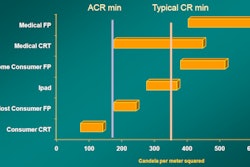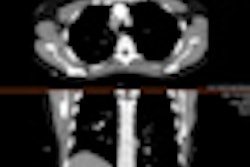WASHINGTON, DC - From a radiology perspective, federal requirements to implement healthcare IT are unnecessary at best and ridiculous at worst. But they're here to stay. At the Society for Imaging Informatics in Medicine (SIIM) meeting, the "Dwyer Lecture" provided a synopsis of achieving meaningful use, government style.
Dr. Keith Dreyer, PhD, vice chairman of radiology for informatics at Massachusetts General Hospital and co-chair of the American College of Radiology's (ACR) IT and Informatics Committee, described strategies for radiologists and vendors to pursue over the next four years. The goal of achieving government requirements is doable: all it takes is perseverance, time, and money.
With an estimated 90% or more of radiology facilities in the U.S. using RIS and PACS, the initiative by the U.S. Centers for Medicare and Medicaid Services (CMS) to motivate healthcare institutions and physicians to adopt electronic medical record technology represents a somewhat backward scenario. But with financial incentives to be gained -- $44,000 per radiologist, to be exact -- and financial penalties for noncompliance looming just a few years away, participation in the program is persuasive.
For radiologists, joining the bandwagon of electronic health record (EHR) users is not as simple as proving that they already practice what is being promoted. Both CMS and the U.S. Office of the National Coordinator for Health Information Technology (ONC) have created a maze of complex, ever-changing rules based on the assumptions that all physicians practice medicine identically, and that healthcare IT systems already achieving the agencies' objectives need to adhere to the government's idea of what an EHR system should be.
The "meaningful use" initiative has launched an era in which radiologists need to think about what the federal government is telling physicians regarding how to improve patient care. "How is care changing?" Dreyer asked. "How are legislation and regulations changing what we need to do everyday because we haven't been self-regulating ourselves?"
"I think there will be more and more pressure from the government and its payor system, so it's in the best interests of both providers and vendors to prepare for this project," he said.
The effort to achieve compliance is worth a potential $1.5 billion in incentive payments for diagnostic imaging providers. And it's offering new opportunities to imaging informatics vendors to develop and sell new products, along with opportunities for consultants to sell their services.
A good place to start is radiologyMU.org, Dreyer recommended. This comprehensive website expands weekly, providing strategic advice and planning tools. Its links facilitate navigation within the websites of government agencies.
Dreyer explained how exceptions could be applied by radiologists to reduce the required 15 core and 10 optional measures of the final stage 1 rules. He showed that interventional radiologists may only need to adopt 17 measures, diagnostic radiologists 12, and exclusive teleradiology practices 10.
However, products that provide these capabilities must be certified. Physicians are required to purchase either certified "complete EHR systems" or "modular" ones, which, when combined, create a complete system that will provide all of the measures -- whether they are needed or not.
Dreyer called this the result of an ill-founded, one-size-fits-all vision of an electronic medical record. He hopes that regulations will change in the future so that physicians will only need to purchase what they will actually use, he said. But for now, software to meet every requirement must be purchased, although "possession" does not require implementation.
"You buy the stuff and put what you don't need and aren't going to use figuratively on the shelf," he recommended.
CMS places meaningful use registrants into two categories: an eligible hospital or an eligible provider. Eligible providers are identified by a patient point-of-service (POS) code. They need to treat at least 90% of their patients in their medical offices, at an urgent care facility, at an ambulatory care facility, or at a freestanding independent clinic or facility. Through April 14, 2010, this definition eliminated radiologists who primarily worked in hospital radiology departments from qualifying for meaningful use incentive funds.
"This presumption remains prevalent today and is the reason your chief information officer may not know that you qualify," Dreyer said. "If you haven't done so already, you need to tell him."
The passage of HR 4851, the Continuing Extension Act of 2010, transferred POS code 22 for outpatient imaging from being within the domain of a hospital to the domain of an eligible provider. As of April 15, 2010, when the legislation became law, if a radiologist has a patient mix that includes at least 30% Medicare patients, and if 10% or less of radiology reports are performed in a hospital inpatient (POS code 21) or emergency room (code 23) setting, he or she qualifies as an eligible provider for meaningful use incentives.
Because of the two categories -- hospitals and physicians -- EHRs may be certified only for hospital use or for ambulatory care use. While many EHRs are certified for both, don't assume this, Dreyer warned. It is imperative to find out the details.
Dreyer described a variety of hospital- and practice-based connectivity scenarios to consolidate and communicate data. These differed based on installed systems and IT configurations related to integrating RIS information with the EHR (either hospital, ambulatory care, or a combination thereof).
He recommended that radiologists meet with practice shareholders to identify the core and menu requirements and exclusions appropriate for their practice. He pointed out that they may wish to report nonutilized requirements with a string of zeros, and they still will be in compliance.
Radiologists and informatics professionals need to assess their IT requirement options to consolidate data that will provide real-time monitoring and attestation data. Most EHRs include dashboards that monitor real-time activities associated with CMS requirements.
"You could be reading 100 exams a day, but you need to verify that these patients are having their blood pressure monitored and are receiving treatment from other caregivers," Dreyer said. "The dashboard enables you to do this. But if a radiologist is using a RIS that is not part of a hospital's EHR, you will need an interface that communicates RIS data to it, so that the data can be audited and the dashboard incorporates radiology information as well."
When a radiology practice contracts with a variety of hospitals with different EHRs, RIS, and PACS, things get complicated. There are no easy answers at this point.
Consultation with RIS and practice management system vendors is the next logical step. Radiologists need to know what their plans are for certification, and to seek their input regarding what IT purchases need to be made or software development performed.
What's important is to identify meaningful use technology and operational strategies that minimize radiologist workflow burdens, Dreyer said. A dashboard is also essential to view meaningful use compliance data in real-time.
Massachusetts General Hospital expects to receive $100 million in incentive payments from CMS. The hospital will receive $42 million, the eligible provider component without radiologists' participation will be $50 million, and the diagnostic imaging department will receive $8 million. Even at Mass. General, hospital executives didn't initially include radiology's contribution because they didn't think that the radiologists could participate, Dreyer said.
Because the hospital had developed its own software, it had to be independently certified, a process that took about four months and was successfully completed in May 2011. The diagnostic imaging department had the following options: not to participate, to use the hospital's EHR, to integrate its radiology IT systems with the hospital's EHR, to certify its RIS and PACS independently, or to purchase a new, already certified system.
The department opted for integration because this was the most logical and cost-effective option. The integration adding patient encounter and radiology report interpretation to the overall database is expected to cost between $10,000 and $20,000 in software development fees.
"The challenges to radiologists are high," Dreyer said. "This program was not designed for us, and it was not intended just for specialists. It's a one-size-fits-all program. Advocacy groups like the American College of Radiology, the American Board of Radiology, and SIIM, to name just a few, are pushing the federal agencies to make this more directed to our specialty."
"Keep in mind that there is a lot of activity on your behalf, and some of this is starting to produce results," he added. "We demanded to U.S. Department of Health and Human Services Secretary Kathleen Sebelius that we be heard. A special hearing on specialty care was held by the ONC Meaningful Use Workgroup several weeks ago, and the ACR was one of a handful of specialties invited to testify."
"I just learned today that the workgroup will submit a separate recommendation, in part because of our testimony," he continued. The group "will submit its recommendations for stage 2 requirements to the ONC HIT Policy Committee as scheduled on June 8. But it announced that it will send another recommendation in about two months that will include specialty issues and address imaging. This is a first. They finally see that they need to develop different requirements for specialties."
He also stressed that radiology advocacy groups are lobbying for the expansion of radiology results to include images.
"For images not to be included in the requirements of medical records is just not right," he said. "For the first time, the regulators see that. We also need to promote image sharing and distribution into the EHR, and as a community, we need to push the use of clinical decision support to make sure that this is added for the best interests of our patients."
Radiologists need to jump on the bandwagon as soon as possible. They face many hurdles, including the need to acquire nonclinically relevant technology, a lack of purchasing influence with their hospitals, limited access to certified radiology IT products, and a lack of flexibility from the ONC.
Meaningful use is not going away, Dreyer concluded, and lobbying to be exempted is not the right approach.
"It is not a good thing for us to request to be out of the picture, because then we, as a profession, might forever be out of the picture," he said. "What the radiology community needs to do is promote specific measures around radiology and request exclusions from requirements that have nothing to do with us."



















